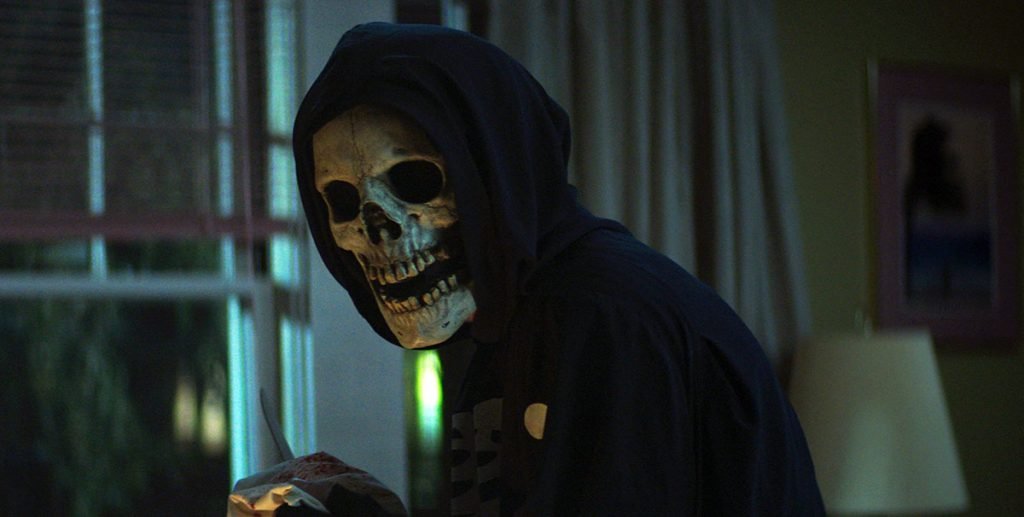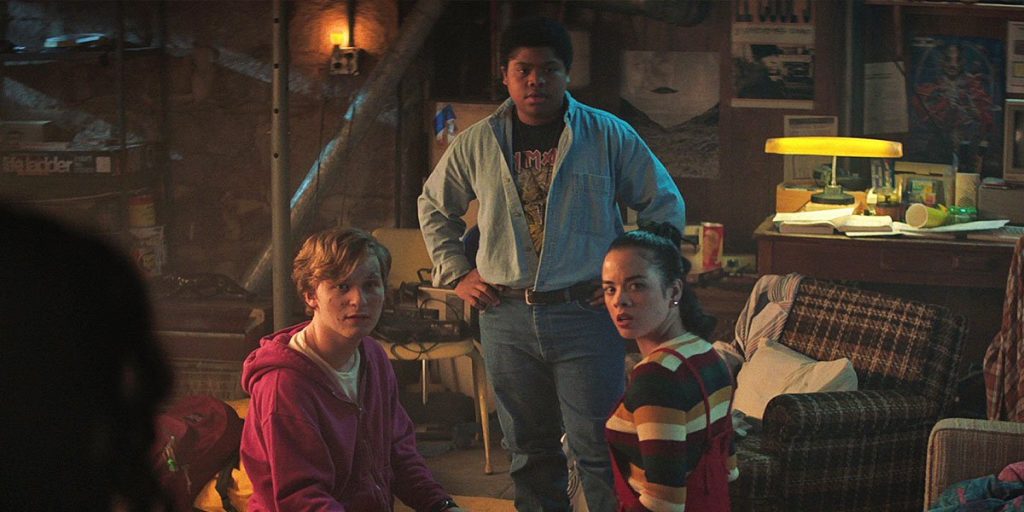Fear Street Part 1: 1994 is an entertaining flick based on RL Stine’s works, though its screenplay could have benefitted from another draft or two.
I’ve got to be honest with you all, folks: I don’t think I’ve ever actually read an RL Stine book. I mean, I remember seeing them on classroom bookshelves when I was a child, but I just never got around to opening one. Because of this, I don’t really have much of an idea of what he’s like as a writer; which tropes he tends to use, how he crafts his horror, how he balances terror with writing for a younger demographic, etc. Outside of knowing that Fear Street Part One: 1994 seems to be intended for a teen audience, I pretty much came into this one blind without much in the way of expectations. So, what did director Leigh Janiak and good ol’ RL bring for us in the first installment?
Fear Street Part 1: 1994 takes place in the town of Shadyside, a small town plagued by an ancient evil responsible for a long series of grisly murders over the course of more than three hundred years. In the year 1994, the evil has returned, and has set its sights on Deena (Kiana Madeira), her friends Kate (Julia Rehwald) and Simon (Fred Hechinger), her brother Josh (Benjamin Flores Jr), and her ex, Sam (Olivia Scott Welch).
First of all, Fear Street does a great job of hooking you in: the opening credits alone introduce a wider mythos surrounding the town of Shadyside in a gripping way that makes you want explore further. The visions of past killers and their crimes frantically flash across the screen as you gain a better perspective of the potency of this evil’s power and how long it has ensnared this town in its grasp. Accompanied with a good opening scene (that I’m positive is an homage to the first Scream movie. In fact, this movie definitely borrows a lot from Scream), Fear Street opens really strongly and will quickly make you want to see more.

Fear Street’s craft is also quite good; first of all, the lighting is great, another example of a horror film that creates a suggestion of darkness while still keeping the picture light enough so we can see what’s going on. It will often use ambient lights emitted from within the scene’s environment to offer new and menacing color pallets to great effect. The costume and character designs of past killers are also (for the most part) really good; you don’t get to see a ton of them in this installment, but there’s enough to make you excited to see more down the road. Not to mention the soundtrack might be the most mid-90s thing conceived all year, boasting songs from the likes of Nine Inch Nails, Garbage, White Zombie, and Cypress Hill. For real, Fear Street goes all in on the 1990s set dressing the same way Stranger Things does for the 1980s, and I’m here for it.
There’s also a fair amount of blood in Fear Street, and I cannot think of a single time it looked bad. The blood and gore in this movie uniformly look pretty good, relying more on practical effects and realistic fake blood, and making very sparing use of CGI. All of this is put to great effect during the more violent scenes, culminating in a particularly gruesome death near the end; it’s one of those deaths where leading up to it you think to yourself “Oh psh, they’re not gonna go through with this, it’s a YA movie, this character will probably get saved at the last second.” But then the character doesn’t get saved, and you see this film’s excellent makeup department at work and you go, “Oh damn!”
Now, we come to the part of the review where I talk about the script… I have mixed feelings about it. The dialogue, while I suppose not terrible, isn’t exactly what I would call “good” either. It gets particularly weird around profanity: this is a R-rated film, so you’d imagine that they can use naughty words as they please, and teenagers, in my personal experience, tend to use colorful vocabularies. And yet the dialogue can’t seem to decide what to do with the word “f***.” It will get substituted for another word like “screw” at points when it would makes sense for a teenager to say “f***.” But then it will get thrown into other contexts, creating sentences that either don’t really make sense, or just aren’t things people in real life say. It feels like the movie was originally supposed to be PG-13, but somewhere along the way got moved up to R and the dialogue struggled to keep up.
The story itself is fine; it’s not exactly groundbreaking, but it’s interesting enough to keep you invested. There aren’t really any interesting trope subversions, though Fear Street does delve heavily into the dumb teenager trope, establishing early on that most of these teens are kind of dumb, so when they inevitably make dumb decisions, it’s at least in character for them. There are a couple of continuity points that may leave you scratching your head (Wait, how did these kids manage to steal an ambulance?), but most of the time these moments are ignorable enough so they’re not too distracting. The script also does a good job of foreshadowing and explaining Fear Street’s supernatural element, allowing the audience to learn about it with the characters without it feeling condescending.
There’s also what I think is supposed to be a non-binary person in the movie; I say “I think” because it’s never explicitly stated that they’re non-binary, but since they sloppily etched a “B” onto the their nametag to turn their name from “Eddy” to “Beddy,” and considering that they also put a thin layer of makeup on their face to juxtapose an otherwise male-presenting body, I think a non-binary person is what the Janiak was going for.
They’re portrayed, however, as a morally dubious person who supplies drugs to minors. While Beddy’s part is really small, their inclusion feels kinda gross and problematic, especially considering they’re the only openly non-binary person in the movie, and thus, whether Janiak intended it or not, is the defacto representative of non-binary folk. Look, I’m not the right person to be discussing this, but there’s a long history of trans and non-binary people being portrayed as decietful, manipulative, and otherwise evil and/or morally dubious in media. And Beddy, here, really isn’t helping to shake that image. If you want to know more about what I’m talking about, Lindsay Ellis and Contrapoints have both made videos on this topic that I’d recommend watching.
Probably my biggest complaint, however, is that character deaths are absolutely not treated with the gravity they deserve. I’m going to go into a mini rant here that will delve into spoilers, so if that bothers you, go ahead and skip to the next paragraph: there are two character deaths in Fear Street that left me truly upset, but not for the right reasons. Late in the movie, Sam learns she could sacrifice herself to save the rest of the group, but Deena refuses to let her do that, wanting to instead exploit a potential loophole to let Sam live. While Deena and Sam are trying to succeed in keeping Sam alive, Kate and Simon are both brutally murdered.
Then at the end of the film, Deena lets them take the fall for the whole murder spree after they’re dead. Deena wouldn’t let her ex girlfriend, with whom it is established that she didn’t have a great relationship anyway, voluntarily die to save her friends, yet she lets her friends die to save her ex girlfriend, and then lets them get blamed for several murders in the town. Are you motherf***ing kidding me?! Like, there’s no grieving of any kind, not even in private! Yet here’s Deena who, despite her friends’ ultimate sacrifice so she can be with her high school slampiece, throws them under the bus and quickly moves on to be in a relationship that, statistically, won’t last very long because, you know, it’s a high school relationship! Hell, Deena also sees Josh, her brother, almost get murdered and doesn’t even try to help him! Damn it, Deena, you’re a bad person! Ugh!
Ultimately, at the end of the day, the question I have to ask myself is: is Fear Street successful in what it sets out to do? I would say that it is. Is this the kind of thing I would have liked when I was a teenager? Yes, I think it is. Am I interested in seeing the other two installments? Yes: there are several cool ideas introduced in here, and I’m curious to see how they get explored in the other installments. Fear Street is far from perfect, but if its goal was to be a fun popcorn movie aimed at teenagers, then I would say that it succeeds.
Read our reviews of horror anthology movies Lore, Scare Us, and Fear Street Part 2 and Part 3!

